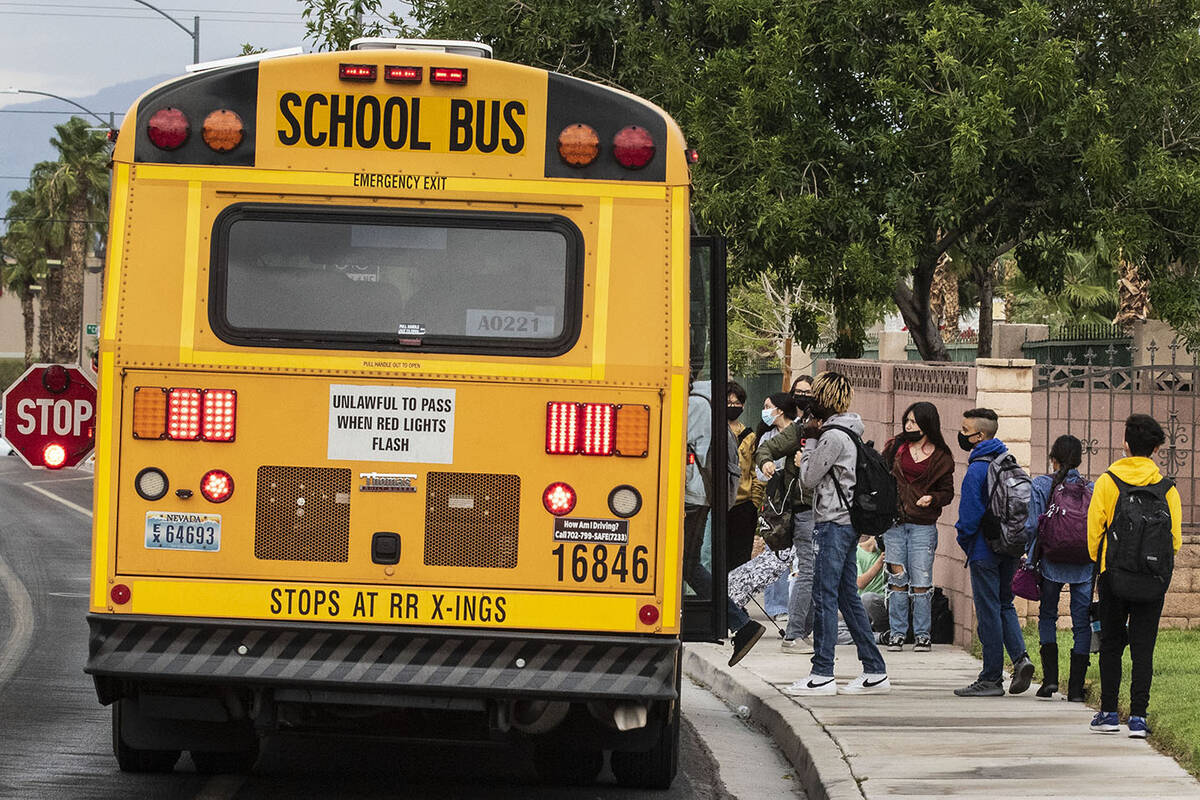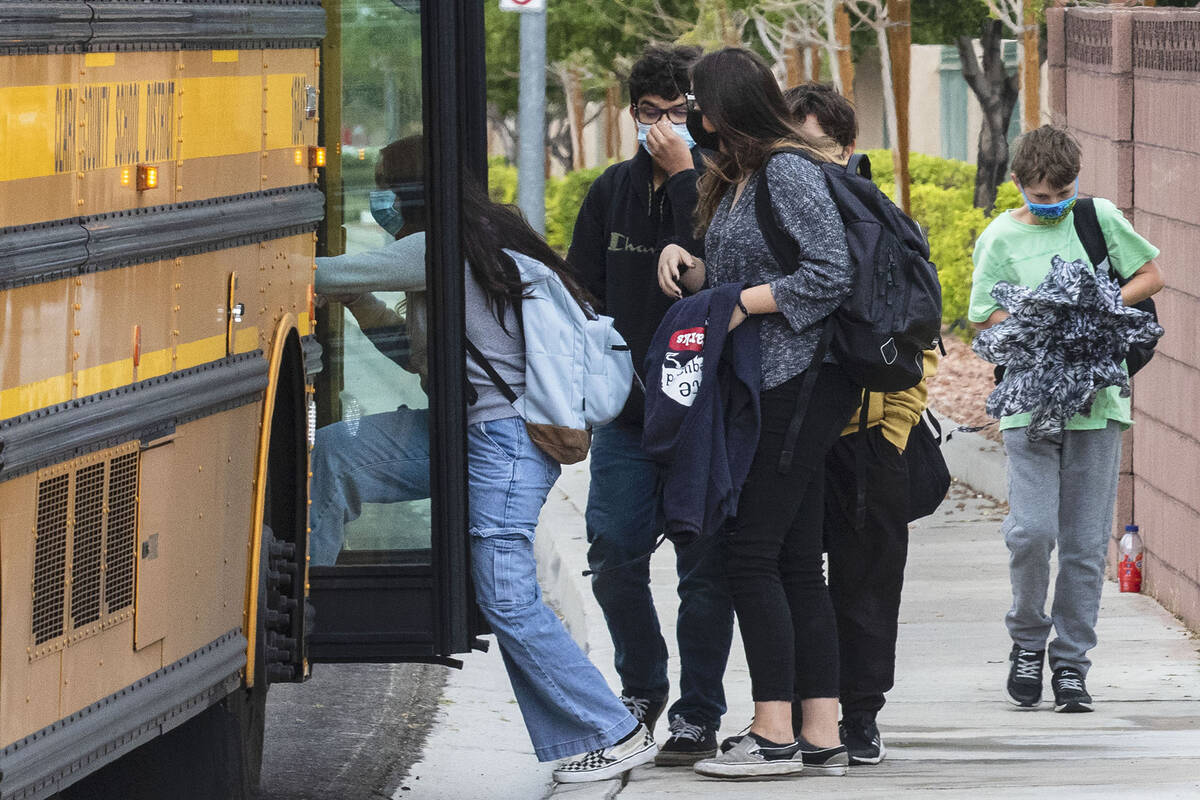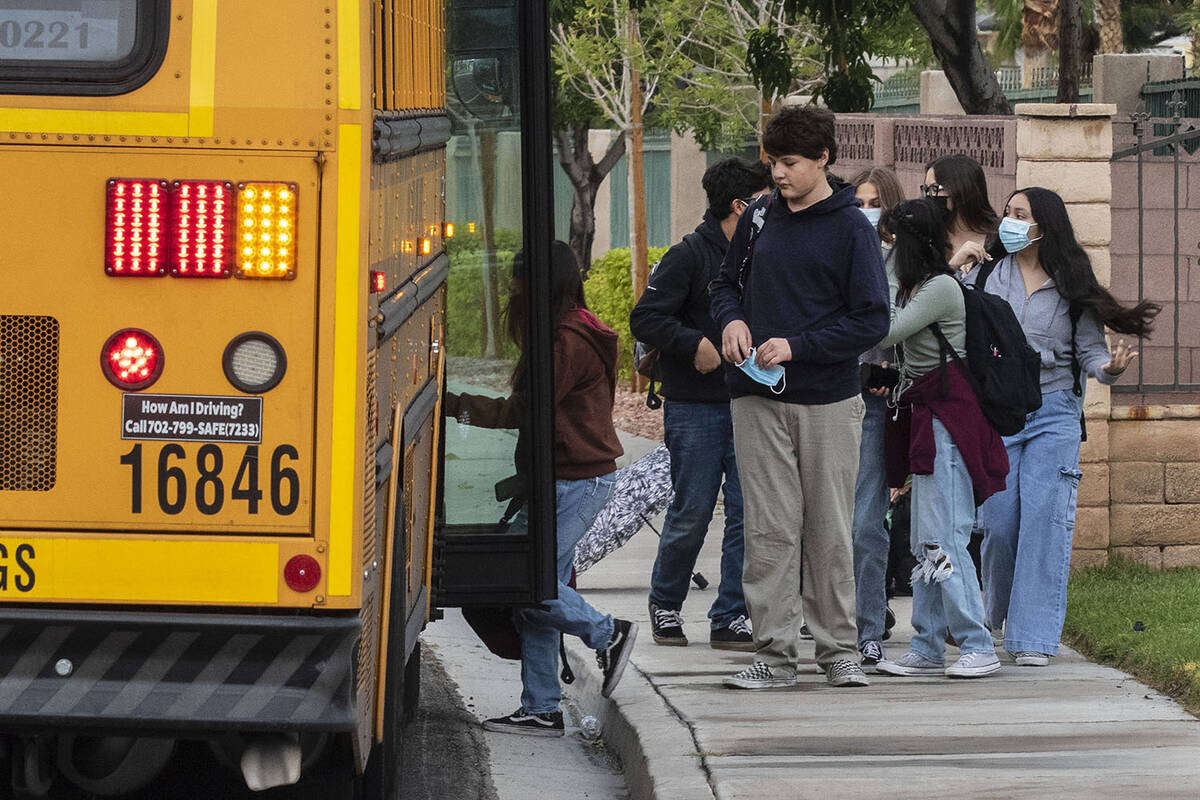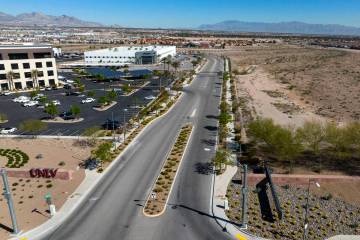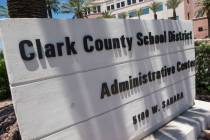RTC to bus some CCSD high school students to ease driver shortage
The Regional Transportation Commission of Southern Nevada will provide bus transportation for some students at 15 Clark County School District high schools to help alleviate a school bus driver shortage.
School district officials announced a partnership between the two agencies at a news conference Wednesday at Spring Valley High School in southwest Las Vegas.
About 4,000 eligible students will begin using services through the “RideOn” initiative Monday in lieu of school district-run routes. Each will receive free monthly RTC bus passes, said Jennifer Vobis, transportation director for the school district.
“RideOn will provide students with access to safe and timely transportation,” Spring Valley High Principal Tara Powell said at the briefing.
Students will ride on existing RTC routes alongside members of the general public. They’ll go to the bus stop nearest their homes and ride to the stop nearest to their school.
Parents have raised concerns since school began in early August about frequent school bus delays and unpredictable service, causing some students to arrive hours late to school.
Last month, the district also announced changes to high school fall sports schedules — including canceling non-conference games and changing days or times for some games — due to transportation issues.
Pandemic worsened driver shortage
The school district has experienced school bus driver vacancies in the past, but “the pandemic has exacerbated that issue,” Chief Operating Officer Mike Casey said, adding that parents and students have shown great patience.
The district currently has about 240 vacant school bus driver positions.
The RideOn initiative is just one remedy to the school bus driver shortage the district is working on, Casey said.
Asked about the potential to expand the initiative, Casey noted that the RTC also is facing a bus driver shortage.
The school district is budgeting up to $1 million this school year for the “RideOn” program, funded through school bus driver vacancies, a district spokesman said.
Schools were selected based on whether they have RTC bus stops nearby that have buses running every 15 to 30 minutes. But not all students at those campuses are eligible.
Participating schools are Bonanza, Chaparral, Cheyenne, Cimarron-Memorial, Clark, Del Sol, Desert Oasis, Durango, Green Valley, Las Vegas, Liberty, Spring Valley, Sunrise Mountain, Valley and Western high schools.
The change will affect 47 school district bus routes, a small fraction of the approximately 1,570 in total.
“A lot of those routes are open,” said Vobis, the district’s transportation director for the school district, meaning they don’t have a regular driver and are being covered by other drivers.
For those routes that do have a driver, those employees will be reallocated to other schools, she said.
RTC Deputy CEO Francis Francis Julien said there are students who already utilize RTC buses to get to school, job sites and extracurricular activities.
“Bus drivers are used to having students on board,” he said.
Addressing security, Julien said the RTC has invested more than $21 million in recent years on contracted security services.
Also, each vehicle is equipped with 12 cameras and riders can use a “Transit Watch” mobile app to report suspicious activity, he said.
Spring Valley High senior Michael Plummer has relied on RTC buses for three years as his primary mode of transportation to and from school, and his job.
He said he’s “really excited” about the RideOn initiative and about having a free monthly RTC pass since he currently pays his fares.
Plummer said having access to RTC buses has allowed him to participate in school extracurricular activities, including after-school robotics, since a late school bus wouldn’t otherwise be provided.
As for his experience riding RTC buses, “It’s usually pretty calm,” Plummer said, adding that people keep to themselves.
He said there’s occasionally a security guard on the buses and he hasn’t encountered any big issues, except with someone occasionally yelling if they’re upset their bus is late.
Not everyone was pleased by the change.
“I got so mad that I wanted to cry,” said Brandi Rollins, whose daughter brought home a letter about the busing change on Friday from Cheyenne High School. “This is just another slap in the kids’ faces that the CCSD is doing to ensure that nobody graduates.”
Rollins said her daughter, a 14-year-old freshman, will use the RTC as a backup, but won’t ride the buses regularly.
Rollins said she and her husband will figure out other ways to get their daughter to and from school, including dropping her off and picking her up, but it will likely involve shifting their schedules.
She said she has safety concerns with students using RTC buses, including the lack of ability to stop traffic when children are boarding, having them waiting in the dark at bus stops where they could be monitored by those with bad intentions, and potentially sketchy people at bus stops.
Some states turn to National Guard
The school bus driver shortage is a national problem, and some states have taken more drastic measures to address it.
In Massachusetts, for example, up to 250 members of the National Guard are being activated to assist with driving buses.
The Clark County Office of Emergency Management brought a similar request Sept. 24 to the Nevada Division of Emergency Management on behalf of the school district, said Meghin Delaney, spokeswoman for Gov. Steve Sisolak. The agency sought to tap into federal COVID-19 relief funds to help pay for the initiative.
“The request was denied by the Nevada Division of Emergency Management for a number of reasons, including the fact that the request was lacking a strong tie to the COVID-19 pandemic and a lack of appropriately qualified members of the Nevada National Guard who possess the correct licensing to drive school buses,” Delaney said in an email to the Review-Journal.
The state is actively working to see if any school district employees who are currently on state active duty “can be returned to their civilian positions at CCSD to help alleviate some of the staffing issues,” Delaney said.
“The Division of Emergency management is also working with other state agencies to see if any seasonal employees have the correct licensing and may be candidates for CCSD to hire on as bus drivers,” she said.
Late school buses
The school district sent out more than 5,700 late school bus alerts during the first month of school. That includes for elementary, middle and high school routes, as well as curb-to-curb service for students who have special needs.
The Review-Journal obtained the information, which spans Aug. 9 through Sept. 7, through a public records request. Public records show estimated delays of anywhere from 10 minutes to one hour.
The number of people who received each notification ranges from just a few to more than 500. It doesn’t represent the number of students impacted, though, since a child may have had two parents who both received an alert.
In language provided by the school district, a standardized bus alert sent via email and text message tells parents how long the delay is and notes that “staff is working diligently to provide safe service.”
The topic of school bus delays came up during a “CCSD Parents” Facebook group virtual question and answer session Sept. 13 with school district officials.
Rebecca Garcia, one of the group moderators, said she has been a school district parent for 15-plus years and has seen some rough years when it comes to busing, “but never like this year.” She asked what’s being done to provide relief.
Casey told parents it’s an unprecedented situation that’s not unique to the Clark County School District. The situation is far from ideal and there’s a sense of urgency to try to get busing on track, he said.
The district is looking at ways to potentially self-fund some retention and hiring incentives, but that has to be agreed upon with employee bargaining groups, Casey said.
The district is also looking opportunities to consolidate bus routes, he said, noting 25 routes had already been consolidated since the beginning of the school year.
The district also took approximately 45 bus drivers who are typically devoted to athletics and are using them to transport students during the school day, Casey said.
Garcia noted that some parents don’t have the flexibility to take their children to school. She also said patience is wearing thin for most families, especially for those with routes that have been inconsistent since the first day of school.
Garcia said some parents have also reported receiving threatening notices from their child’s school about accumulated tardies as a result of late buses.
Deputy Superintendent Brenda Larsen-Mitchell told parents that schools have to document whether a student was tardy, but a child won’t be penalized if they’re late due to bus delays.
Casey said the bus driver shortage has grown worse since the COVID-19 pandemic began in early 2020 when there were school building closures and a switch to distance education for about a year.
The district was able to keep school bus drivers on during distance education, but essentially had a hiring freeze due to budget concerns and couldn’t pick up additional drivers, Casey said.
Another challenge: There’s a lag time between when a new driver is hired and when they’re ready to start on the job.
It’s typically a two-month process from when a candidate is selected to when they’re driving students independently, Casey said, noting they must undergo training and a background check. The district pays for new hires to obtain their commercial driver’s license (CDL).
Parent concerns
Several parents voiced frustration about school busing during a Sept. 23 school board meeting.
Kyle Rogers told the board he’s a foster parent and his child is bused across the valley from where they live in old Henderson to Arbor View High School.
He said the bus is regularly 40 to 45 minutes late, noting he had screenshots from the last 10 days with that information.
“And that makes my student even more late to his first period,” Rogers said.
He said his child has severe post-traumatic stress disorder. Being late to his first period class, with all of those eyes watching him and wondering why he was tardy, activates that PTSD, he added.
Rogers said his child isn’t going to his first period class anymore because being late causes too much anxiety. Instead, he’s walking the hallways and is now facing with disciplinary issues, he said.
He said he needs the busing issue to be fixed. “It is a disability rights issue and I need it fixed like tomorrow.”
Board President Linda Cavazos asked him to stick around for a couple of minutes, saying she believed someone from the district would be speaking with him.
Mother Tenitta Franklin told the School Board that one of her children, who is slated to graduate from high school in 2022, works at Starbucks, so she looks at his bank account often.
She found he was missing $17 from the account and her son told her he took an Uber or Lyft in order to get to school.
Franklin said she knows the school district is short on school bus drivers. “And I understand that you guys don’t know what to do about the system, but give (them) public school bus passes or something.”
She also asked to be reimbursed for the $17.
Contact Julie Wootton-Greener at jgreener@reviewjournal.com or 702-387-2921. Follow @julieswootton on Twitter.
More information
For additional details on the "RideOn" initiative, visit transportation.ccsd.net/ride-on.



